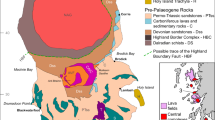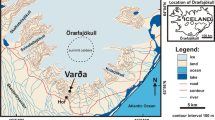Abstract
In subaerial volcaniclastic sequences structures formed by ice blocks can provide information about a volcano's history of lahar generation by glacier melt. At Volcán Hudson in Chile, catastrophic lahars were initiated by eruption-induced melting of glacier ice in August and October 1991. They transported large ice blocks 50 km down the Rio de los Huemules valley to the sea. Large current crescents with lee-side lenses were formed where ice blocks were deposited during waning stages of the flood. When stranded blocks of ice melted, they left cone-shaped and ring-shaped heaps of ice-rafted debris on the sediment surface. Several hundred ice blocks were completely buried within the aggrading lahar sediment, and when these melted circular collapse pits formed in the sediment. Collapse types included subsided coherent blocks of sediment bounded by an outward-dipping ring-fracture, trapdoor structures with horseshoe-shaped fractures, downsag pits with centroclinal dips locally up to 60°, pits with peripheral graben and crevasses, piecemeal (highly fragmented) collapse structures and funnel-shaped pits containing disaggregated sediment. A sequence of progressive collapse is inferred in which initial downsag and subsidence on an outward-dipping ring fracture produces a small diameter pit. This is followed by widening of the pit by progressive development of concentric ring fractures and downsag outside the early formed pit, and by collapse of overhanging pit walls to produce vertical to inward-dipping walls and aprons of collapse debris on the pit floor. The various structures have potential for preservation even in regions prone to high rainfall and flooding, and they can be used to indicate that former lahars contained abundant blocks of ice.
Similar content being viewed by others
References
Allen JRL (1984) Sedimentary Structures: their Character and Physical Basis. Developments in Sedimentology 30. Elsevier, Amsterdam, 1256 pp
Best JL (1992) Sedimentology and event timing of a catastrophic volcaniclastic mass-flow, Volcán Hudson, Southern Chile. Bull Vocanol 54:299–318
Branney MJ (1995) Downsag and extension at calderas: new perspectives on collapse geometries from ice-melt, mining, and volcanic subsidence. Bull Volcanol 57:303–318
Cevo J (1978) Informe preliminar sobre erupcion del Volcan Hudson norte o Volcan Huemules (2nd edn 1981). Trapananda 1 1978 (2nd edn 1981): 35–42
Collinson JD (1971) Some effects of ice a river red. J Sedim Petrol 41:557–564
Dionne JC (1985) Formes, figures et faciès sédimentaires glaciels des estrans vaseux des régions froides. Palaeogeogr Palaeoecol 51:415–451 [in French]
Dionne JC (1992) Ring structures made by ice in a muddy tidal flat, St. Lawrence estuary, Canada. Sedim Geol 76:285–292
Fuenzalida RP (1976) The Volcan Hudson. In: Gonzales-Ferrano (ed) Proc IAVCEI Symp Andean Antarctic. Volcanol Problems: 78–87
Gardner CA, Neal CA, Waitt RB, Janda RJ (1994) Proximal pyroclastic deposits from the 1989–1990 eruption of Redoubt Volcano, Alaska — stratigraphy, distribution, and physical characteristics J Volcanol Geotherm Res 62:213–250
Greene HG (1970) Microrelief of an arctic beach. J Sedim Petrol 40:419–427
Jónsson J (1980) Um Kötluhlaup. Náttúrufrædingurinn 50:81–86 [in Icelandic]
Komuro H (1987) Experiments on cauldron formation: a polygonal cauldron and ring fractures. J Volcanol Geotherm Res 31:139–149
Longva O, Thoresen MK (1991) Iceberg scours, iceberg gravity craters and current erosion marks from a gigantic Preboreal flood in southeastern Norway. Boreas 20:47–62
Maizels JK (1977) Experiments on the origin of kettle-holes. J Glaciol 18:291–303
Maizels J (1989) SEdimentology, paleoflow dynamics and flood history of jökulhlaup deposits: paleohydrology of Holocene sediment sequences in southern Iceland sandur deposits. J Sedim Petrol 59:204–223
Maizels J (1992) Boulder ring structures produced during Jökulhlaup flows. Geogr Annal 74:21–33
Major JJ, Newhall CG (1987) Snow and ice perturbation during historical volcanic eruptions and the formation of lahars and floods. Bull Volcanol 52:1–27
McDonald BC, Shilts WW (1975) Interpretation of faults in glaciofluvial sediments. In: Jopling AV, McDonald BC (eds) Glaciofluvial and Glaciolacustrine SEdimentation. Soc Econ Paleontol Mineral Spec Publ 23:123–131
Naranjo JA (1991) Nueva erupción del Volcán Hudson. Rev Geol Chile 18:183–184 [in Spanish]
Naranjo JA, Moreno H, Banks NG (1993) La erupción del Volcán Hudson en 1991 (46°S), Region XI Aisén, Chile. Boll Sev Nac Geol Minera-Chile 44:1–50 [in Spanish]
Pierson TC, Janda RJ, Thouret J-C, Borrero CA (1990) Perturbation and melting of snow and ice by the 13 November 1985 eruption of Nevado del Ruiz, Colombia, and consequent mobilization, flow and deposition of lahars. J Volcanol Geotherm Res 41:17–66
Scasso RA, Corbella H, Tiberi P (1994) Sedimentological analysis of the tephra from the 12–15 August 1991 eruption of Hudson volcano. Bull Volcanol 56:121–132
Smith GA, Fritz WJ (1989) Volcanic influences on terrestrial sedimentation. Geology 17:375–376
Smithsonian Institution (1991) Hudson (Chile). Bull Global Volcanism Network 16 (No 7):12–5
STern CR (1991) Mid-Holocene tephra on Tierro del Fuego (54°S) derived from the Hudson Volcano (46°S): evidence for a large explosive eruption. Rev Geol Chile 18:139–146
Thorarinsson S (1958) The Öræjajökull eruption of 1362. Acta Naturalia Islandica 2:1–50 [in Icelandic]
Thouret J-C (1990) Effects of the November 13, 1985 eruption on the snow pack and ice cap of Nevado del Ruiz volcano, Colombia. J Volcanol Geotherm Res 41:177–201
Author information
Authors and Affiliations
Rights and permissions
About this article
Cite this article
Branney, M.J., Gilbert, J.S. Ice-melt collapse pits and associated features in the 1991 lahar deposits of Volcán Hudson, Chile: criteria to distinguish eruption-induced glacier melt. Bull Volcanol 57, 293–302 (1995). https://doi.org/10.1007/BF00301289
Received:
Accepted:
Issue Date:
DOI: https://doi.org/10.1007/BF00301289




